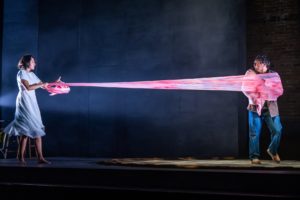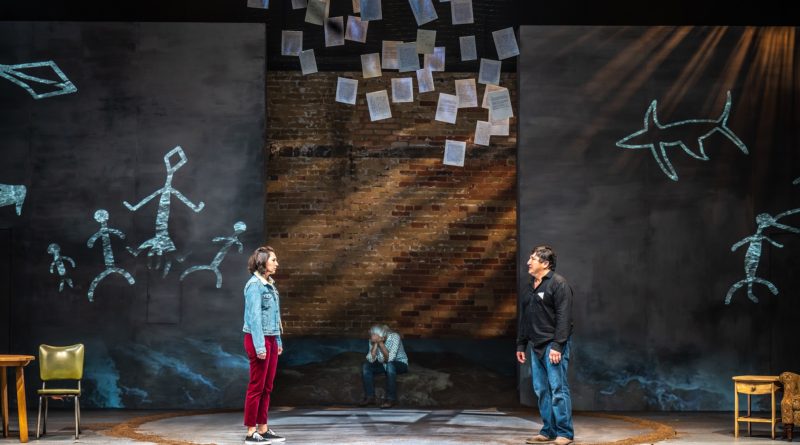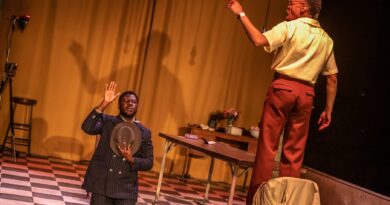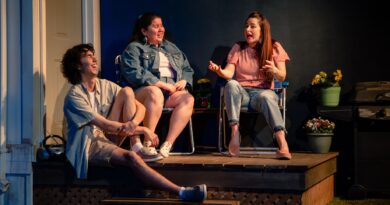Soulpepper & Native Earth’s Where the Blood Mixes: An overwhelmingly alive, full-sensory tour de force

Where the Blood Mixes is likely not what you expect.
The haunting new Soulpepper and Native Earth Performing Arts co-production of Kevin Loring’s acclaimed play brings to life difficult and complex subject matter: the intergenerational and interfamilial trauma experienced by Canada’s Indigenous people because of colonialism and the residential school system.
You expect it to be heartbreaking, which it is. You may have heard that the characters are often funny, which they also are. And under Jani Lauzon’s skilled direction, the production achieves something you may not expect: it is both breathtakingly beautiful and stunningly alive.
After an arresting but mysterious opening song sung by Tara Sky’s Christine, the plot begins in a slow and talky way. The stakes feel small, as if we’re watching a CBC comedy series from decades past. We’re in a bar, and Indigenous customers Mooch (Craig Lauzon) and Floyd (Sheldon Elter) are trading mostly good-natured barbs with each other and with George (Oliver Dennis), the mostly good-natured white bartender.
It’s funny: all that’s missing is the laugh track. But as the scene elongates, there’s an edge . . . something beneath the surface. The “Shum’ma” (white) bartender seems a decent type. But there’s cognitive dissonance in the way he disavows personal accountability for the legacy of colonialism, yet preys on addictions which are the result of that legacy. For instance, he sells lottery tickets and alcohol to customers like Mooch, who can pay only with the stolen grocery money of his girlfriend June (Valerie Planche).
The men’s conversation turns to compensation available for local residential school victims – compensation which is scaled to match the amount of suffering endured. Could this be Mooch’s ironic ticket out of his financial difficulties? The problem for Mooch is that “you gotta talk about it,” a seemingly throwaway line that reverberates through the rest of the play.

We also learn that Floyd’s daughter Christine – taken from him as a small child (we’re not sure why)—has written him a letter. After a long search, she has located him, and intends to visit. With that visit will come a reckoning with the circumstances of her adoption by white parents – circumstances that stem from abuse at the St George’s Residential School when Mooch, Floyd, June and Anna (Christine’s dead mother) were just children.
They are survivors: damaged, resilient and beautiful souls whom we root for. Their story of intergenerational trauma proves emotionally harrowing, but unexpectedly redemptive and hopeful because the marvellous cast is operating within a synaesthetic and multi-layered production.
James Dallas Smith, “Musician”, is on-stage from before the play opens. He bears periodic silent witness to the unfolding drama, but more often, his slide guitar unfurls a haunting backtrack of mood music, plaintive cries and atmospheric sound effects which unify the production’s disparate components and moods.
Ken McKenzie’s set design and Samay Arcentale Cajas’ video and production design skilfully realize several interconnected physical and metaphysical locations. Huge screens dominating left and right are bisected by a zone of brick wall with stone in front of it. If we’re in an outdoor setting, the screens are filled with natural scenes of forest or river. The space between represents stone, shore or train track slicing through unspoiled nature: places in the vastness where these characters can situate themselves as they grope after meaning.
Those huge screens are also a conduit to the spirit world, as symbolized in the movement of sparse pictographs across them: images of fish, the sturgeon that eats dead fish, and the osprey that seems to represent the spirit.
But whenever we’re indoors, these screens are dark. They are flat walls, and the open stage is colonized by furniture that makes it either George’s bar or Floyd’s home. In these scenes, the characters have difficulty breaking free: from the bar’s tables and chairs with their bottles of beer; from the lottery ticket machine that, siren-like, summons them to the back of the bar; and from the armchair in his home that a despairing and drunk Floyd is unable to rise from.
“Where the Blood Mixes” refers to Kumsheen, now known as Lytton, which is where the Fraser River meets the Thompson River and also the spot where the trickster figure Coyote’s heart is said to have landed after he was torn apart in battle. Central to the Nlaka’pamux Nation, the setting is both sacred and metaphorical. At key moments, the image of water is projected on a step across the front of the stage – visualizing a sense of liminality, simultaneity and motion that inform the whole production. Where these rivers – and where the blood – mixes on this stage, there is inextricable overlap of past with present. Some of these locations exist both now and in the past. Memories can be accessed and unlocked. Can a new current, such as the returning Christine, dislodge the buried trauma that roots Mooch to the bar and Floyd to his armchair?
Where the Blood Mixes is timely and important because it compellingly manifests the intergenerational trauma created by Canada’s residential school system. And because it equally compellingly asserts the possibility of resilience, reconnection and healing.

But the reason you shouldn’t miss this production is that it encodes this narrative within an achingly beautiful – and overwhelmingly alive – full-sensory experience that is much more than the sum of its excellent visual, auditory, kinaesthetic and spiritual parts.
Where the Blood Mixes is likely not what you expect. Don’t expect to leave it behind when you leave the theatre.
Reserve tickets to Where the Blood Mixes here.
© Scott Sneddon, SesayArts Magazine, 2022
About The Author
Scott Sneddon
Scott Sneddon is Senior Editor on SesayArts Magazine, where he is also a critic and contributor.
Visit About Us > Meet the Team to read Scott’s full bio …




